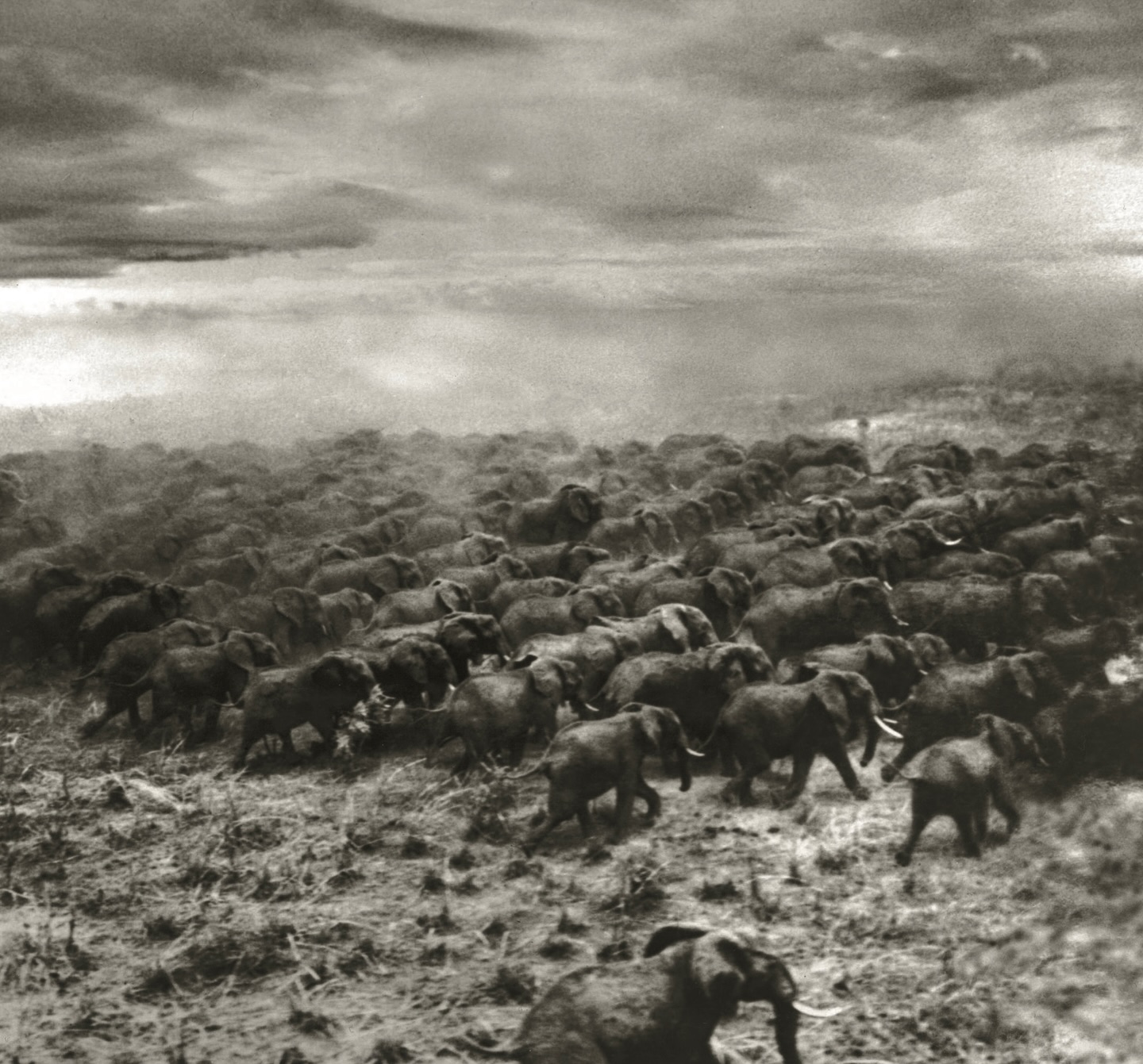In 1965, a Single Photograph Froze an Elephant Army in Time — And the World Never Looked at Wildlife the Same Again
There are photographs that show you something — and then there are photographs that shake you. Peter Beard’s 1965 image of hundreds of elephants marching across the dry, open land of Tsavo National Park in Kenya is the kind that stays with you forever. You don’t just look at it — you feel it. It pulls you into a moment that no longer exists, but somehow still breathes through the dust in the air and the heavy footsteps frozen in time.
At first glance, it’s almost overwhelming. A gray haze, a cloud of dry earth hanging above the landscape, and within it — an army. An endless tide of elephants moving with rhythm, direction, and unspoken unity. They aren’t panicked. They aren’t fleeing. They’re moving — together, as if powered by a shared instinct, a code written into their bones.
It’s not a zoo. It’s not a controlled reserve. It’s the wild. It’s real.
Beard didn’t just capture elephants. He captured power, memory, and a reminder of something we’re often too busy to see — what the world looks like when humans step aside.
What’s haunting is that even though this was taken less than a century ago, it already feels ancient. Seeing a herd of elephants this size today is almost impossible. Not because elephants have changed — but because we have. The world around them has.
That’s why this one photograph, black and white and cracked with time, has become something far more than an image. It’s a voice.
Herds, History, and What We Almost Lost
Elephants don’t move in chaos. They move in stories. Every group is built on family — grandmothers, daughters, calves barely taller than the brush. The matriarch leads the way, using memories of ancient migration paths. These paths aren’t written on maps. They live in her mind, passed down from her mother and grandmother. She knows where the water used to be, where danger lurks, and where shelter can still be found after a storm. That’s the heart of the herd — not just the muscle, but the memory.
Peter Beard knew this. That’s why he spent so much time in East Africa — not to just take pictures, but to feel the place. To live in it. His journals weren’t just observations. They were raw, sometimes chaotic reflections on nature, beauty, and the loss creeping in from all corners of the world. He didn’t want to be a safe observer. He wanted to be a witness. Sometimes, that meant getting too close — emotionally and physically.
The elephants of Tsavo were different then. Their numbers were large. The land still stretched, untouched in many directions. But even by the 1960s, Beard could see the writing on the wall. Poaching was growing. Land was shrinking. And in time, even these mighty herds — these rolling thunderclouds of life — would start to fade.
And they did.
In the decades that followed, elephant populations across Africa declined sharply. Driven by ivory, by greed, by land disputes, and often by ignorance, entire generations were wiped out. Not just individuals, but memories. Paths forgotten. Wisdom lost.
So when people look at Beard’s photo today, it doesn’t just show wildlife. It shows what was — and hints at what could still be again, if we listen.
Social media sometimes stumbles across this image. And when it does, the reaction is always the same: disbelief, awe, heartbreak. Some people don’t believe it’s real. Others think it must be edited, or part of a movie. Because seeing that many elephants in one place? That feels like fiction.
But it was real. And that’s both the magic and the tragedy of it.
Conservationists today are trying. Elephant populations have stabilized in some places, even grown slightly. But the world they knew — the vastness, the safety in numbers, the uninterrupted land — that’s not easy to restore. It takes more than donations. It takes will. It takes governments, communities, and yes, even people thousands of miles away, caring about animals they’ll never see.
What Beard’s photo does best is cut through the noise. It doesn’t lecture. It doesn’t preach. It just shows. And when people see it, something shifts.
You start to remember that the Earth is old, and beautiful, and full of lives that don’t look like ours — but are just as layered, just as bonded, just as deserving.
And if we don’t protect them, we lose more than just animals.
We lose something inside ourselves.

Daniel Reed is a curious mind with a passion for breaking down how the world works. With a background in mechanical engineering and digital media, he turns complex ideas into easy-to-understand articles that entertain and inform. From vintage tools and modern tech to viral internet debates and life hacks, Daniel is always on the hunt for the “why” behind the everyday. His goal is simple: make learning feel like scrolling through your favorite feed — addictive, surprising, and fun.
